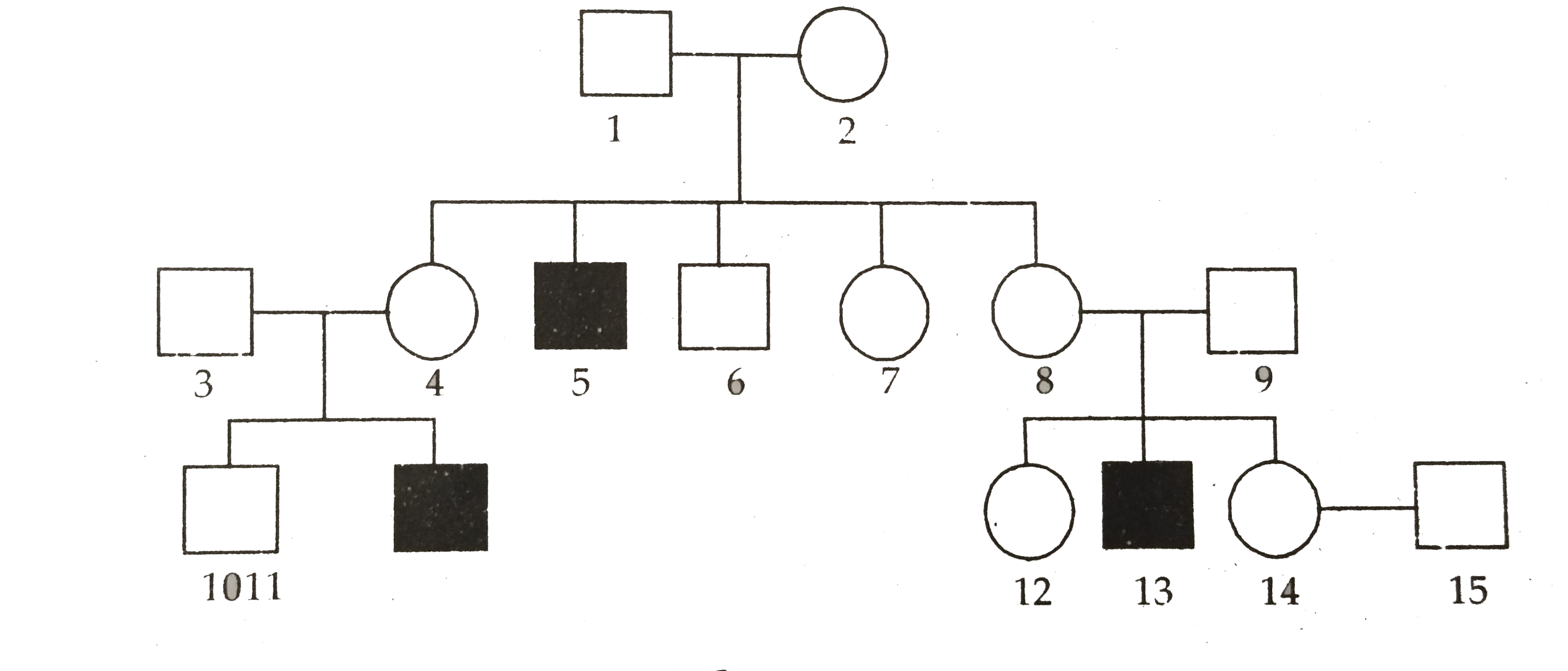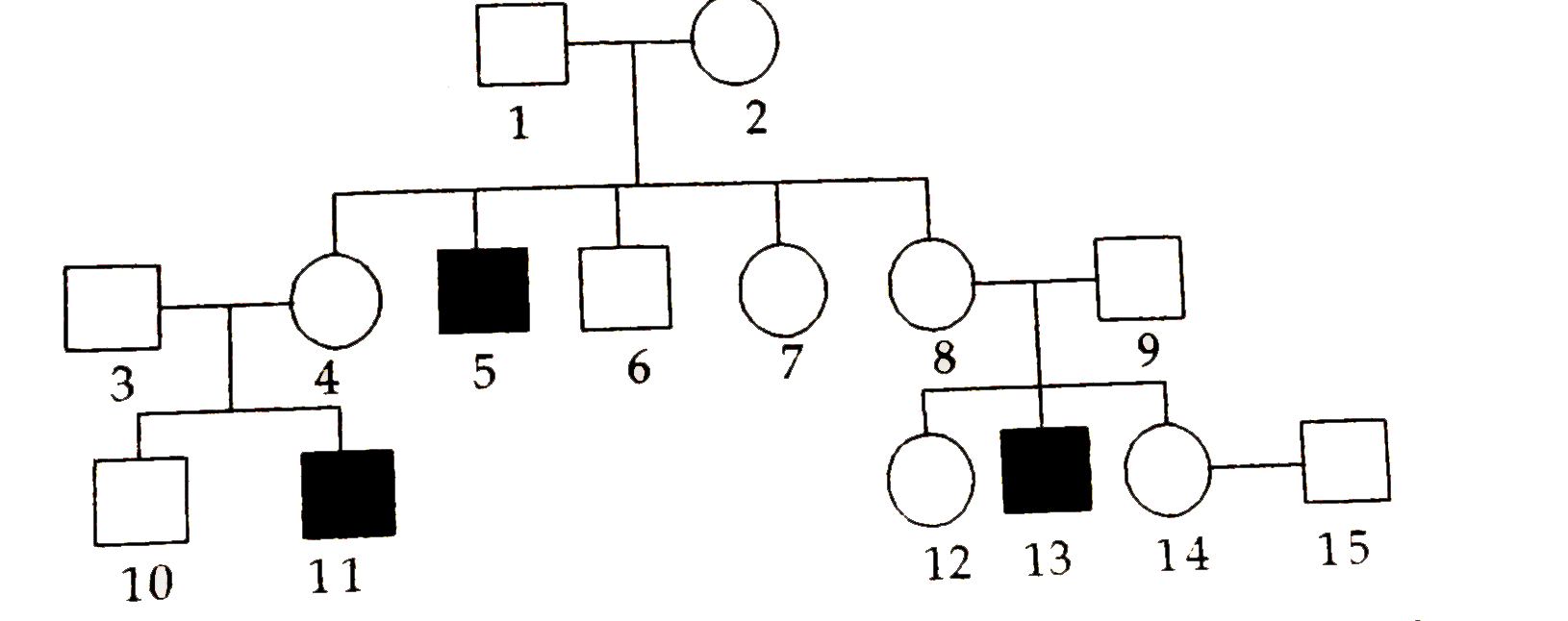If a boy's father has haemophilia and mother is heterozygous what is the chance that the boy will inherit haemophilia
0.5
0.25
0.75
1
The correct Answer is:A
To solve the problem of determining the chance that a boy will inherit haemophilia from a father who has the condition and a mother who is heterozygous, we can follow these steps:
Step 1: Understand the Genetics of Haemophilia
Haemophilia is a sex-linked recessive disorder, which means it is carried on the X chromosome. Males have one X and one Y chromosome (XY), while females have two X chromosomes (XX).
Step 2: Determine the Genotype of the Parents
- The father has haemophilia, so his genotype is X^hY (where X^h represents the X chromosome with the haemophilia allele).
- The mother is heterozygous, meaning she has one normal allele and one allele for haemophilia. Her genotype is X^HX^h (where X^H represents the normal allele).
Step 3: Set Up a Punnett Square
To find the probability of the offspring's genotypes, we can set up a Punnett square with the mother's alleles on one side and the father's alleles on the other.
| | X^H | X^h |
|----------|-----------|-----------|
| X^h | X^HX^h | X^hX^h |
| Y | X^HY | X^hY |
Step 4: Analyze the Offspring Genotypes
From the Punnett square, we can see the possible genotypes for the offspring:
1. X^HX^h (female, carrier but not affected)
2. X^hX^h (female, affected)
3. X^HY (male, normal)
4. X^hY (male, affected)
Step 5: Determine the Probability for Males
Now, we focus on the male offspring:
- There are two male offspring possibilities: X^HY (normal) and X^hY (affected).
- Out of these two possibilities, one results in haemophilia (X^hY).
Step 6: Calculate the Probability
The chance that a boy will inherit haemophilia is:
- Probability = Number of affected males / Total number of males = 1 (affected) / 2 (total males) = 0.5 or 50%.
Conclusion
Thus, the chance that the boy will inherit haemophilia is 50%.
---
Haemophilia is a sex-linked recessive disorder, which means it is carried on the X chromosome. Males have one X and one Y chromosome (XY), while females have two X chromosomes (XX).
- The father has haemophilia, so his genotype is X^hY (where X^h represents the X chromosome with the haemophilia allele).
- The mother is heterozygous, meaning she has one normal allele and one allele for haemophilia. Her genotype is X^HX^h (where X^H represents the normal allele).
To find the probability of the offspring's genotypes, we can set up a Punnett square with the mother's alleles on one side and the father's alleles on the other.
|----------|-----------|-----------|
| X^h | X^HX^h | X^hX^h |
| Y | X^HY | X^hY |
From the Punnett square, we can see the possible genotypes for the offspring:
1. X^HX^h (female, carrier but not affected)
2. X^hX^h (female, affected)
3. X^HY (male, normal)
4. X^hY (male, affected)
Now, we focus on the male offspring:
- There are two male offspring possibilities: X^HY (normal) and X^hY (affected).
- Out of these two possibilities, one results in haemophilia (X^hY).
The chance that a boy will inherit haemophilia is:
- Probability = Number of affected males / Total number of males = 1 (affected) / 2 (total males) = 0.5 or 50%.
Thus, the chance that the boy will inherit haemophilia is 50%.
Topper's Solved these Questions
- CHROMOSOMAL BASIS OF INHERITANCEBOOK - DINESH PUBLICATION ENGLISHCHAPTER - CHROMOSOMAL BASIS OF INHERITANCEEXERCISE - Check Your Grasp
57 Videos
- CHORDATA- PROTOCHORDATABOOK - DINESH PUBLICATION ENGLISHCHAPTER - CHORDATA- PROTOCHORDATAEXERCISE - CYG
11 Videos
- COELENTERATA AND CTENOPHORA (OR CNIDARIA AND ACNIDARIA)BOOK - DINESH PUBLICATION ENGLISHCHAPTER - COELENTERATA AND CTENOPHORA (OR CNIDARIA AND ACNIDARIA)EXERCISE - CYG
10 Videos
Similar Questions
If father has pseudorickets and mother is normal then :-
View Solution
If II-2 marries to a normal man, what is the chance of her first child being a haemophilic boy :
View SolutionA normal woman whose father had haemophilia married a normal man. What is the chance of occurrence of disease in the progeny?
View SolutionIf phenotype of father is blood group .O. and genotype of mother is heterozygous .A., what are the possible genotypes and phenotypes of the offspring ?
View SolutionIf father is normal while mother is carrier of haemophilia
View SolutionIf there is a history of haemophilia in the family, the chances of male members becoming haemophilic are more than that of the female.
(a) Why is it so ?
(b) Write the symptoms of the disease.
View SolutionWhat is true for colour blindness and haemophilia ?
View SolutionHaemophilia is a sex linked recessive disorder of humans. The pedigree chart given below shows the inheritance of haemophilia in one family. Study the pattern of inheritance and answer the questions given

Give all the possible genotypes of the members 4,5 and 6 in the pedigree chart.
(b) A blood test shows that the individual 14 is a carrier of haemophilia. The member numbered 15 has recently married the member numbered 14. What is the probability that their first child will be a haemophilic male? Show with the help of Punnett square.
View SolutionHaemophilia is a sex-linked recessive disorder of humans. The given pedigree chart shows the inheritance of haemophilia in one family. Study the pattern of inheritance and answer the questions given.
(a) Give all the possible genotypes of the members 4, 5 and 6 in the pedigree chart. (b) A blood test shows that the individual 14 is a carrier of haemophilia. The member number 15 has recently married the member numbered 14. What is the probability that their first child will be a haemophilic male?

View SolutionHaemophilia is a sex linked recessive disorder of humans. The pedigree chart given below shows the inheritance of Haemophilia in one family. Study the pattern of inheritance and answer the questions given.

(a) Give all the possible genotypes of the members 4, 5 and 6 in the pedigree chart.
(b) A blood test shows that the individual 14 is a carrier of gaemophilia. The member numbered 15 has recently married the member numbered 14. What is the probability that their first child will be a haemophilic male ? Show with the help of Punnett square.
View Solution
